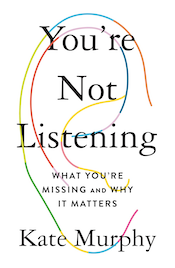
You’re Not Listening: What You’re Missing and Why It Matters
by Kate Murphy
In a world obsessed with talking, listening has become a lost art. Yet, it remains the cornerstone of connection, understanding, and growth. Kate Murphy’s You’re Not Listening reveals why we struggle to listen, the consequences of this oversight, and the transformative power of fully tuning in to others. Murphy demonstrates how to sharpen your listening skills and harness their potential to enhance relationships, build trust, and thrive in a noisy world. By learning to listen deeply, you’ll cultivate stronger relationships, resolve conflicts more effectively, and discover meaning in conversations that others overlook.
Why Listening Matters
Listening is the gateway to empathy, the bridge to meaningful relationships, and the foundation of personal and professional success. When you listen well, you do more than hear words—you understand context, emotions, and intention. Yet, most of us listen poorly, distracted by our own thoughts, assumptions, and digital devices.
The irony? Listening isn’t just beneficial for others—it’s beneficial for you. It broadens your perspective, strengthens your connections, and helps you evolve into the best version of yourself. Listening also shapes your identity. The voices you engage with affect your values, decisions, and sense of self. By listening deeply and purposefully, you align your actions with the person you aspire to be.
Why We’re Terrible at Listening
Murphy identifies three main obstacles to effective listening:
- Distraction: Technology distracts our attention from real conversations. The rise of social media and endless notifications keeps us tuned out instead of tuning in.
- Assumptions: We often think we know what others will say before they’ve said it, which cuts conversations short and blocks understanding.
- Impatience: The brain processes thoughts faster than speech, leading us to rush others or finish their sentences.
Listening as a Cultural Deficit: Modern society prioritizes speaking over listening, creating a void where empathy and connection should thrive. Murphy critiques this imbalance, linking it to isolation and division, and calls for a cultural shift to value listening as a fundamental skill.
The Neuroscience of Listening
Listening is more than hearing. Studies reveal that when you truly listen, your brain waves synchronize with the speaker’s, creating a powerful connection that enhances understanding and trust. When you make an effort to listen deeply, you not only improve communication but also create meaningful relationships.
How to Become a Better Listener
Murphy shares actionable strategies for mastering the art of listening:
- Be Curious: To listen well, channel your inner toddler—ask questions, explore subtext, and avoid assuming you already know what someone will say. Curiosity helps you focus and keeps conversations fresh.
- Beware of Assumptions: Preconceived notions act as earplugs. When you assume you know the point, you stop listening. Instead, approach conversations with a clean slate.
- Resist the Urge to Interrupt: Let the speaker finish their thoughts without rushing to respond.
- Listen for the Unspoken: Nonverbal cues like tone, body language, and silence often carry more meaning than words. Paying attention to these details helps you grasp the whole story.
- Stay Present: Put down your phone, make eye contact, and give the speaker your full attention.
- Pause Before Responding: Build a habit of pausing a few seconds before speaking. It shows thoughtfulness and gives others space to continue.
- Mirror Back Key Points: Summarize what you hear to confirm understanding and signal attentiveness. Respond thoughtfully, not reflexively.
- Create Distraction-Free Zones: Turn off your phone, close your laptop, and give people your undivided attention.
- Ask Open-Ended Questions: Avoid “yes” or “no” questions. Instead, invite reflection with prompts like, “What does that mean to you?” or “Can you elaborate?”
- Practice Listening in Low-Stakes Settings: Use everyday interactions—with baristas, coworkers, or family—as opportunities to practice active listening.
- Expose Yourself to Diverse Perspectives: Listening to different voices broadens your worldview, challenges your assumptions, and fosters a more nuanced understanding of the world.
Silence is Your Ally
Embrace pauses in conversation. They allow other participants to process their thoughts and share more deeply. Resist the urge to fill every space with words.
When to Stop Listening
Not all conversations are worth your time. Murphy advises setting boundaries, especially when listening becomes emotionally draining or toxic. Protecting your energy ensures you can listen effectively where it matters most.
The Morality of Listening
Murphy points out that listening is more than a skill; it’s a moral responsibility. Listening actively shows respect and care for others. By making people feel heard, you create spaces where they can be their authentic selves. This moral aspect of listening is crucial in leadership, relationships, and community building. It’s a responsibility we all share to listen and understand others, and it’s a key aspect of building considerate and respectful relationships.
The Takeaway: Listening is Transformative
You’re Not Listening is a call to action to reclaim the art of listening in an age of distraction—a plea to slow down, pay attention, and rediscover the transformative power of listening. By choosing to truly listen, you gain access to the wisdom, emotions, and stories of others, enriching your own experience.
The book serves as both a critique of modern communication and a practical guide to becoming a better listener. It offers tools and strategies for improving listening skills, ready for application in daily interactions. Murphy’s insights help readers build stronger connections, deepen their understanding of others, and enrich their lives.
Book Details and Where to Find It
Find this book at your public library or on Amazon: e-book | Audiobook | Print
Amazon rating: 4.5 of 5
Goodreads rating: 4.1 of 5
Page count: 284
Publication date: Jan. 7, 2020
Author website: https://www.journalistkatemurphy.com
* The Amazon links are affiliate links. We may receive a small commission from Amazon on your purchase at no additional cost.
